Essential Parts of a Window for Homeowners
Knowing the right names for parts of your window can help you avoid confusion. Read through these important window parts terms and definitions for Pella windows and you’ll be set.
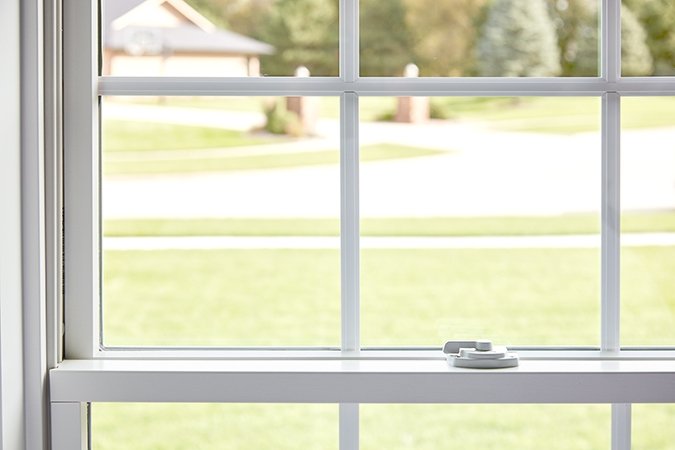
KEY TAKEAWAYS
- Understanding window parts is essential for effective communication with manufacturers and installers, ensuring you select the right product for your needs.
- Double-hung and casement windows feature distinct components like sashes, locks, grilles, and weatherstripping that impact both functionality and aesthetics.
- Choosing between wood, fiberglass, or vinyl windows can affect durability, maintenance, and energy efficiency, making material selection a key consideration.
Windows do much more than frame a view. They impact your home’s comfort, energy efficiency, style and even security. But with so many window components and terms, it can be hard to know what’s what. This guide will walk you through the most important window parts—from the frame to the glass to the hardware—so you can feel more confident whether you're shopping for replacements or just learning how your windows work.
Window Basics: Essential Terminology
Before diving into detailed parts and styles, it helps to start with a broad understanding of the essential terms used when discussing windows. This foundational knowledge will make it easier to identify what kind of window you have and what parts you may need to replace, repair or upgrade.
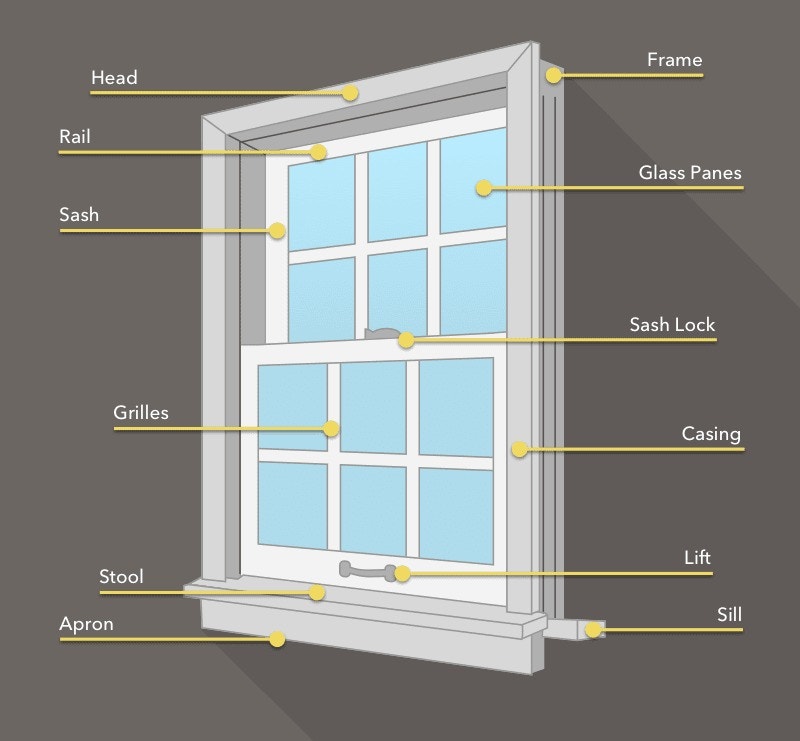
Window Vocabulary 101: Key Terms to Know
At its core, a window is made up of a frame, sash and glass. Add in components like grilles, weatherstripping and locks, and you get a system that balances form and function. See the labeled diagram above for a visual reference of these essential window parts.
- Frame: The outer structure that holds the entire window assembly.
- Sash: The moveable or fixed framework that holds the glass.
- Glass (or glazing): The transparent pane(s) that let in light while insulating your space.
- Hardware: Operating mechanisms like locks, lifts, cranks, and balances.
- Grilles: Decorative elements that divide the glass for a multi-pane look.
Understanding Window Frames and Their Components
The window frame is the outer structure that holds the entire window assembly in place. It forms the foundation of the window, anchoring it to the wall and supporting other critical elements like the sash and glass. A well-built frame ensures proper installation, smooth operation, and long-term performance.
A standard window frame includes four key parts:
- Head: The top horizontal section of the frame.
- Jambs: The vertical sides that run from the head to the sill.
- Sill: The bottom exterior piece, designed to shed water away from the home.
- Stool: The interior ledge at the base of the window, often used as a small shelf or design detail.
These components work together to provide structure, seal out the elements, and support the window’s moving parts.
Window frames are available in several materials, each with its own strengths. Wood delivers timeless beauty and natural insulation. Vinyl is popular for its affordability and low maintenance. Fiberglass stands out for its strength and energy efficiency.
Window frame material affects more than just appearance—it influences how well a window insulates, how much upkeep it needs, and how it performs over time. Whether you're choosing new windows or evaluating existing ones, understanding the frame is a crucial step in selecting the right fit for your home.
Types of Windows and Their Unique Parts
Not all windows are built the same, and that’s a good thing. From classic double-hung to sleek casement or sliding styles, each window type has its own way of opening, closing and sealing. Getting familiar with your window type makes it easier to spot which parts are in play and how they work together to deliver ventilation, light, and energy performance.
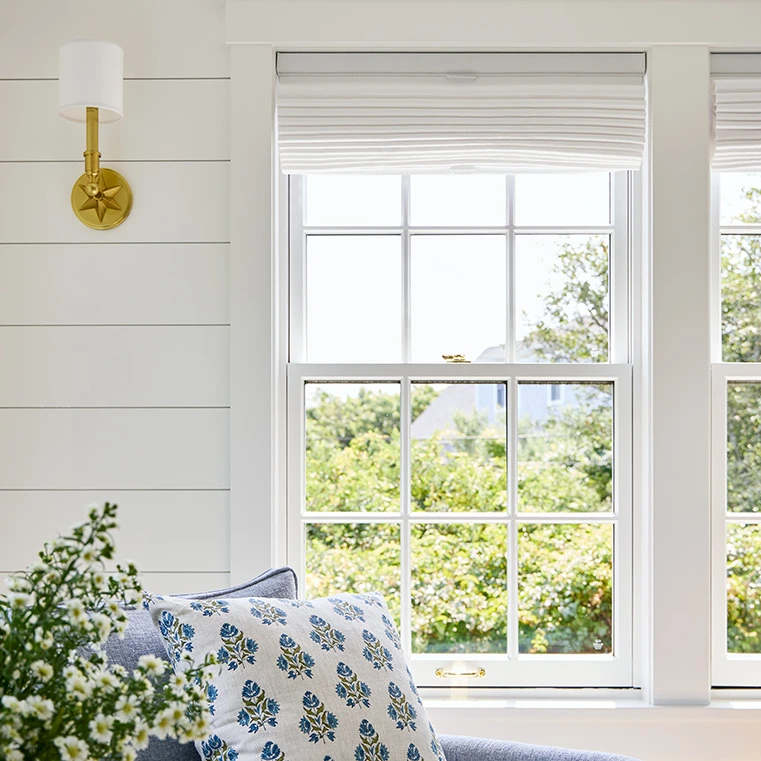
- Double-hung: Two movable sashes slide vertically. Includes a check rail where the sashes meet.
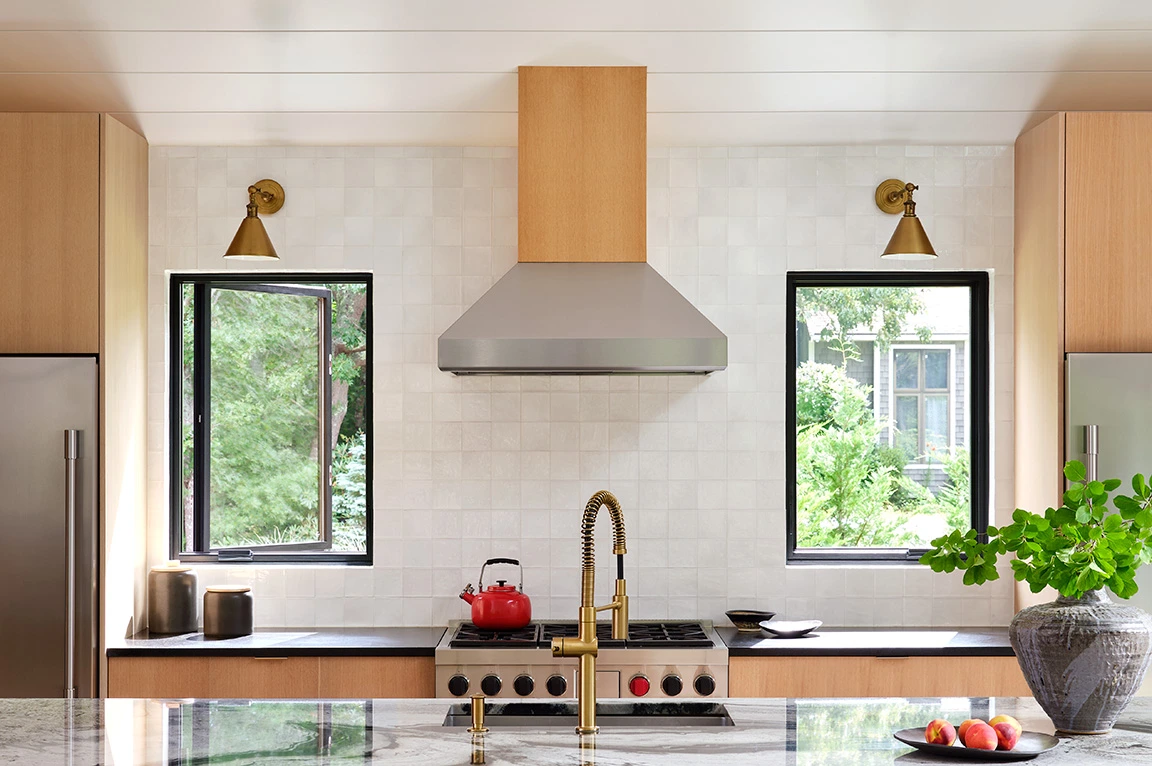
- Casement: Hinged on one side and opens outward via a crank.
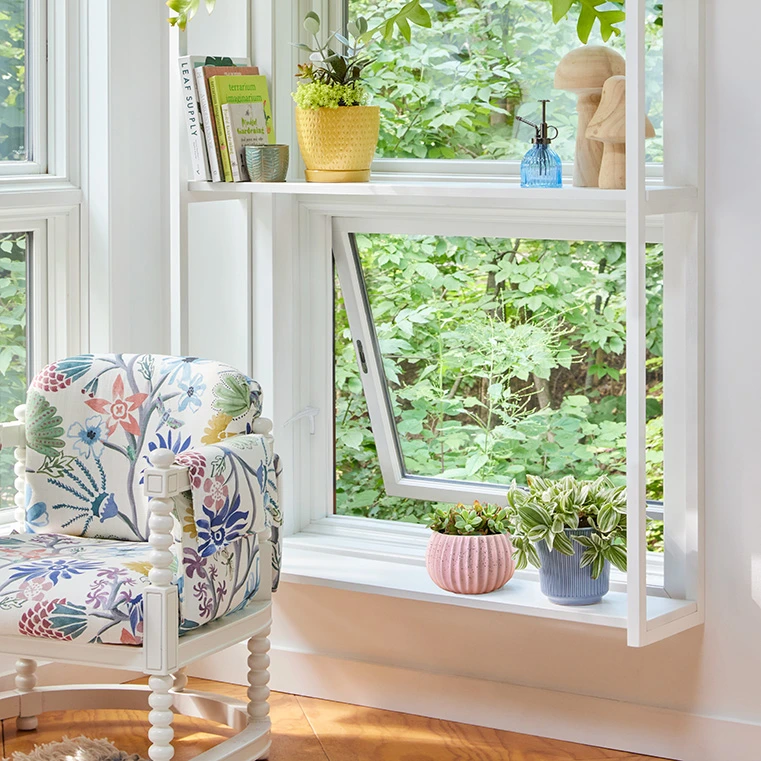
- Awning: Hinged at the top, opening outward—great for ventilation during light rain.
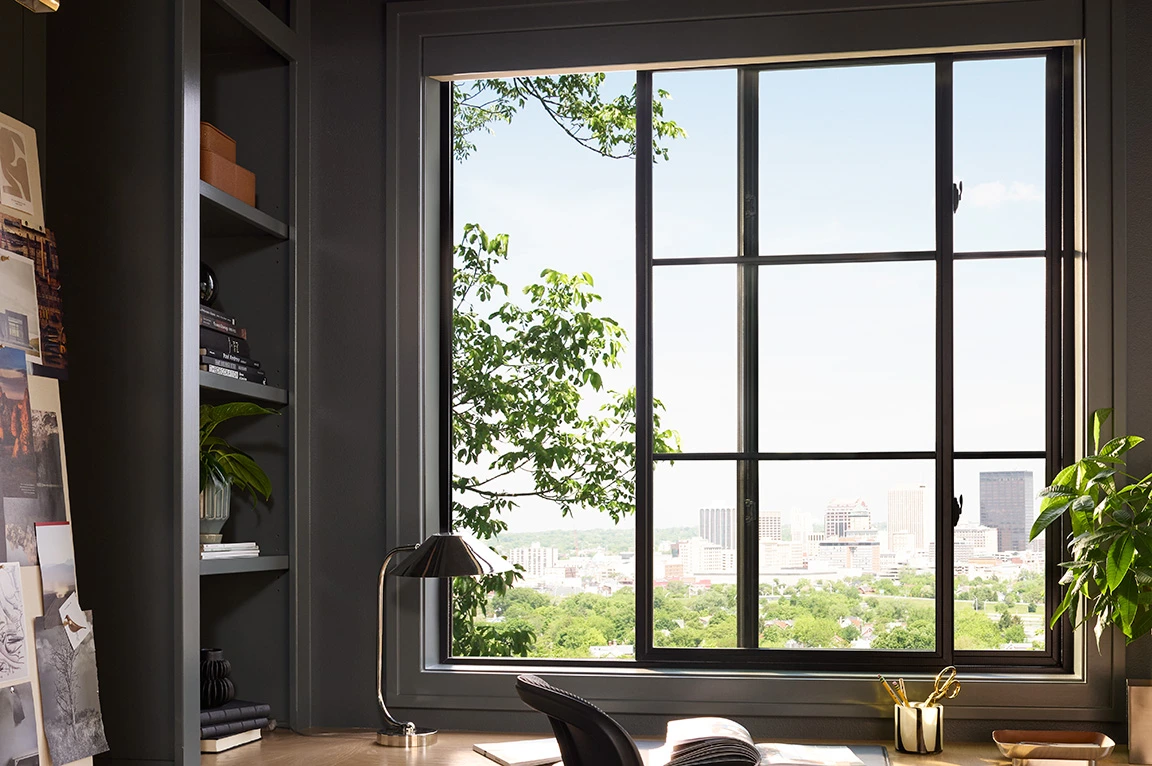
- Sliding: Sashes glide horizontally on a track.
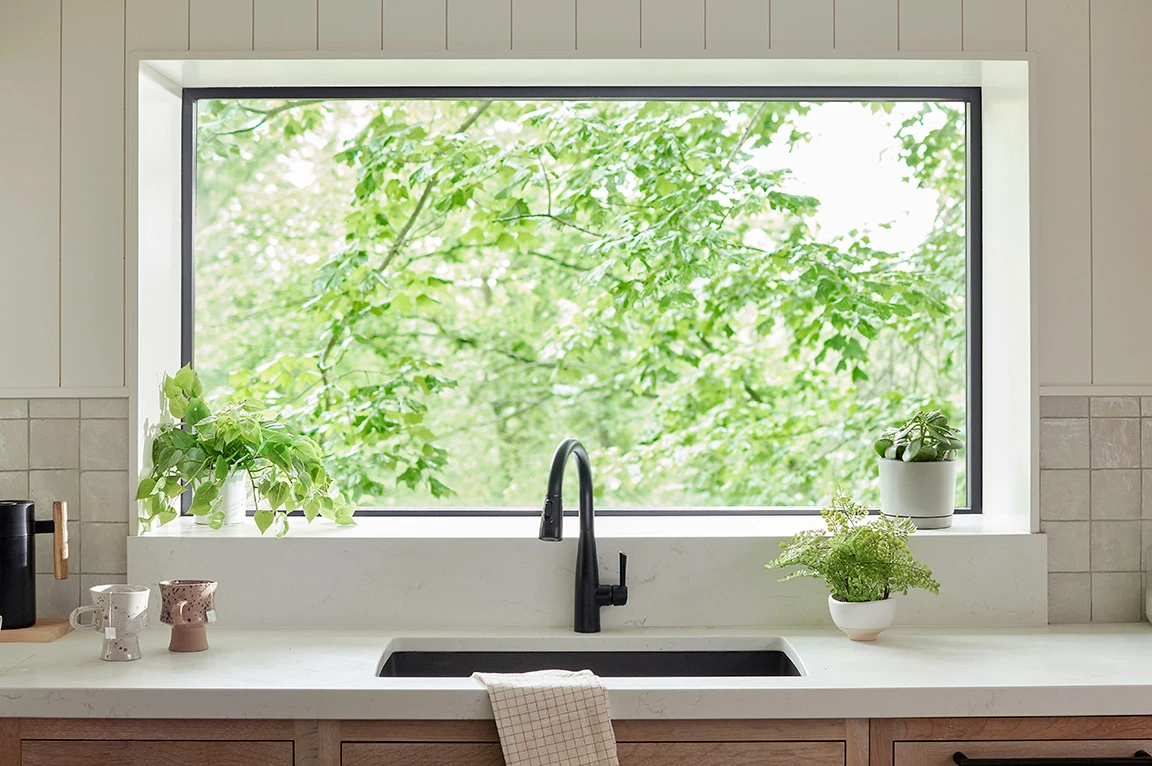
- Fixed or picture: No moving parts; just a large, stationary pane for maximum light and views.
Window Sash Components Explained
The sash does a lot of heavy lifting in a window’s design, it’s what holds the glass in place and makes the window operable. Whether it slides, swings or stays put, the sash plays a major role in both how your window functions and how it looks. It’s the part you interact with most, and its design impacts everything from airflow and energy efficiency to how easy it is to clean.
Fixed vs. Moveable Sashes: What's the Difference?
- Fixed sash: This sash does not open. It’s common in picture or transom windows and offers excellent insulation and security.
- Moveable sash: Found in double-hung, casement, sliding, and awning windows. These allow for airflow and easier cleaning.
Each sash type offers a different balance of ventilation, view, and energy efficiency.

Stiles, Rails, and Other Sash Elements
A sash is made of several key structural elements:
- Stiles: The vertical side pieces.
- Rails: The horizontal top and bottom pieces.
- Check rail: The meeting point of the upper and lower sashes in a double-hung window, forming a weather seal.
- Muntins: Narrow strips that divide the glass into multiple panes, used either for structural support or decoration.
Window Glass and Glazing Options
Glass might seem like the simplest part of a window, but it does a lot more than meets the eye. Beyond giving you a clear view outside, your window’s glazing plays a big role in keeping your home comfortable, quiet and energy efficient. The right glass can help block out street noise, hold in heat during winter and reflect it away in the summer, all while letting natural light pour in.
Single, Dual, and Triple-Pane Glass Explained
- Single-pane: One layer of glass. Offers minimal insulation.
- Dual-pane: Two layers with air space or argon gas between. Great insulation and standard in most homes.
- Triple-pane: Three layers of glass with two insulating air spaces. Best for soundproofing and cold climates.
Many modern windows use Low-E coatings to reflect UV and infrared light, helping regulate indoor temperature year-round. And while single-pane glass is no longer common in modern homes, the real choice for most homeowners is between dual- and triple-pane options. Each offers a different balance of insulation, noise control, and cost. If you're weighing the pros and cons, it's helpful to understand the difference between double- and triple-pane windows so you can choose the right fit for your climate and energy goals.
Grilles and Decorative Elements
Window grilles or grids can do more than just divide a pane of glass, they can completely transform the look and feel of your home. Whether you’re restoring a historic property and want to stay true to its original charm, or you’re designing a sleek, contemporary space with clean lines, grilles offer a subtle but powerful way to express your style. From classic colonial patterns to minimalist modern designs, the right grille choice adds both architectural character and a personal touch to your windows.
Types of Window Grilles and Their Applications
Grilles visually divide a windowpane into smaller sections. Popular patterns include:
The right grille style can enhance curb appeal and complement your home’s architecture.
Full-Divided Light vs. Other Grille Options
- True divided light: Individual panes of glass separated by muntins.
- Simulated divided light (SDL): Grilles on both sides of a single pane of glass.
- Grilles-between-glass (GBG): Grilles sealed inside the glass unit for easy cleaning.
- Removable grilles: Can be taken on and off for a streamlined look or better cleaning access.
Spacer Bars and Energy Considerations
In multi-pane windows, spacer bars create an insulating air space between the panes.
Materials include:
- Aluminum: Durable but conducts heat.
- Stainless steel: Improves energy performance.
- Foam/composite: Used in warm-edge spacer systems to reduce heat transfer.
Spacers help improve insulation and energy efficiency—especially when combined with argon gas and Low-E coatings.
Window Hardware and Operating Mechanisms
Window hardware might not be the first thing you notice, but it plays a big role in how your windows feel and function every day. From smooth-opening sashes to secure locking systems, the right hardware makes your windows easier to use, more secure and even more energy efficient. Whether you're opening up your space for a breeze or locking up for the night, dependable hardware ensures your windows work exactly how and when you need them to.
Locks, Handles, and Security Features
- Sash locks: Secure the sashes in single- or double-hung windows.
- Cam locks: Rotate to tighten the seal between sashes.
- Multi-point locks: Secure casement and awning windows at multiple points for better security.
- Handles and operators: Used to open and close casement, awning, and sliding windows.
Quality hardware adds durability and enhances security—some windows even feature laminated glass for extra protection.
Hardware Finishes and Style Options
From matte black to oil-rubbed bronze, hardware finishes let you match your home’s aesthetic. Choose finishes that offer:
- Corrosion resistance for humid climates
- Period-appropriate designs for older homes
- Easy maintenance and long-term durability
Balance Systems for Hung Windows
Balance systems make it easier to open and close vertically sliding windows by offsetting sash weight. Types include:
- Rope and pulley (in older homes)
- Spiral balances
- Spring balances
- Block and tackle systems
Knowing your balance type helps with repairs and smooth operation over time.
Trim, Casing and Finishing Elements
Trim may seem like a finishing touch, but it does more than just frame your window, it completes the space. Interior and exterior trim help bridge the gap between your window and the wall around it, creating a clean, polished look while also helping to block out drafts, moisture and dust. Whether you're going for classic or contemporary, the style and material you choose can subtly elevate the character of a room or give your exterior a crisp, architectural edge.
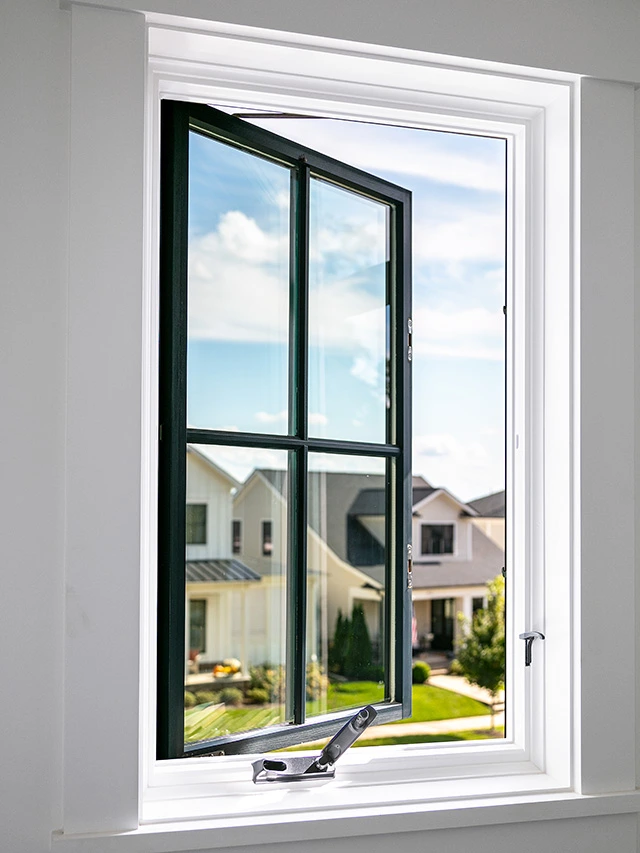
Interior Trim and Casing Options
Casing is the interior trim that hides construction gaps and adds visual interest. Options include:
- Wood: Classic and customizable
- MDF: Cost-effective and paintable
- PVC: Moisture-resistant—ideal for bathrooms and basements
Window trim profiles range from sleek and modern to ornate and traditional.
Exterior Brick Mould and Weather Protection
Brick mould is the exterior trim surrounding the window frame. It helps seal out water and enhances the visual transition between the wall and window. Combined with proper flashing, it adds style while defending against the elements.
Sills, Stools, and Bottom Components
- Sill (exterior): Directs water away from your home.
- Stool (interior): The flat shelf-like ledge at the window base.
- Apron: Decorative trim installed just below the stool.
These finishing pieces not only add a polished look but help with drainage and protection.
Understanding the anatomy of a window gives you more control, whether you’re replacing old units, improving energy efficiency, or planning a new build. From sash to sill, every part plays a role in your window’s performance and appearance.


